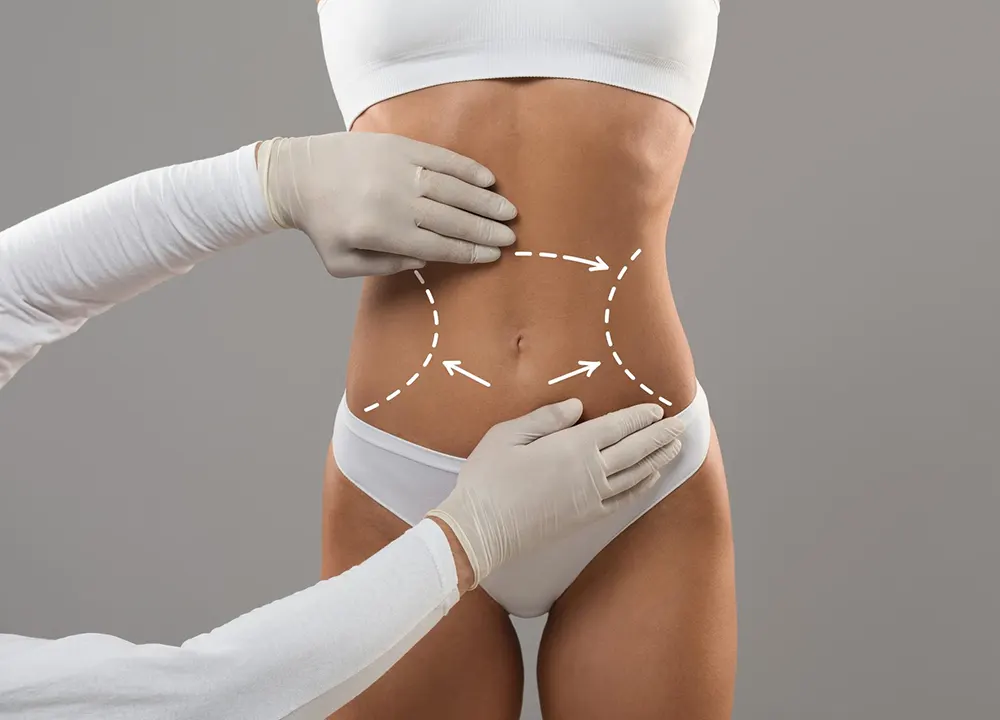- Call Today +90 537 762 59 24
- Open Hour Open 24 Hours

Abdominoplasty, commonly referred to as tummy tuck surgery, is a surgical procedure designed to correct or eliminate deformities in the abdominal area. This sought-after procedure is often chosen by individuals, especially men, dealing with concerns such as sagging skin following obesity surgery or postpartum developments. The primary causes of deformities in the abdominal region, which can be effectively addressed through abdominoplasty, stem from excess skin and subcutaneous tissue.
Various factors contribute to sagging in the abdominal region, including multiple pregnancies, post-obesity weight loss, abdominal muscle laxity, and intra-abdominal fat accumulation. Tummy tuck surgery involves the removal of excess skin and fat from the abdominal area, accompanied by the tightening of connective tissue sheaths (fascia) surrounding the abdominal muscles through sutures. Additionally, the remaining portion is reshaped. It's worth noting that while abdominoplasty can eliminate stretch marks (striae) in the lower abdominal area, it does not address stretch marks outside this region.
Individuals, both men, and women, aged 18 and above, in good general health and without contraindications for surgery, are suitable candidates for tummy tuck. Thoroughly assessing the individual's medical history, including the impact of previous pregnancies, weight fluctuations, and any prior surgical interventions, is crucial before proceeding with the surgery. It is recommended to postpone the operation if the patient plans to lose weight or become pregnant, and motivation to approach the target weight before the operation is encouraged.
Before undergoing abdominoplasty, careful consideration of potential risks is essential. These include the impact of the surgery on future pregnancies, considerations for patients with heart conditions, diabetes, or blood clotting disorders, and attention to issues related to wound healing. Medications, herbal supplements, and lifestyle factors such as smoking and intense pre-operative exercises should also be thoroughly examined and disclosed to the surgeon.
Abdominal recovery may not be fully achievable through exercises after multiple pregnancies or post-obesity weight loss, as the skin and abdominal muscles may not return to their original state. Excessive weight gain, whether through diet or gastric bypass surgeries, can lead to abdominal wall relaxation and excess skin tissue, necessitating abdominoplasty for removal of fat and loose skin.
Tummy tuck aims to correct abdominal shape deformities resulting from skin laxity and muscle deformation. Although not primarily intended for weight loss, it can assist individuals in losing some weight, particularly when addressing abdominal deformity due to obesity. Additionally, abdominal hernia repair surgery can be performed during abdominoplasty, and the procedure can reduce the appearance of stretch marks in the abdominal area.
In a standard abdominoplasty, incisions are made in the lower abdominal area, extending from Cesarean section incisions on both sides toward the pelvic bones' front projections. The abdominal skin is lifted over the abdominal muscles, the sheaths of which are tightened with sutures. Excess fat and skin are removed, and the navel is repositioned. Liposuction may be performed concurrently for enhanced results. A "mini abdominoplasty" with a shorter incision is considered for concerns limited to the lower abdomen's "apron" area.
Let's take a look at frequently asked questions about tummy tuck surgery
There are no specific disadvantages to abdominoplasty, but common surgical risks such as infection, wound opening, and pulmonary embolism should be considered.
A detailed physical examination, recording of abdominal marks, evaluation of hernias, and thorough examination of abdominal wall condition and tension are crucial. Pre-operative photographs should be taken, and patients should be informed that swelling may persist due to intra-abdominal fat.
Initially, scars are pink and prominent, with normalization of color expected approximately one year post-surgery.
Generally, three days are sufficient for incision healing, and hidden stitches eliminate the need for stitch removal.
Normal work life can typically be resumed 6-8 weeks after abdominoplasty.
Abdominoplasty does not prevent pregnancy, but it is recommended to wait 6 months to 1 year before planning a pregnancy to preserve gains achieved through the procedure.
Weight gain during pregnancy after abdominoplasty is similar to normal weight gain, with no increased risk. Some regression in appearance may occur during the baby's growth process.
Pregnancy-related stretch marks may still occur, but the risk can be minimized through proper diet, exercise, and considering abdominoplasty after completing the pregnancy process.
While not mandatory, efforts to reach an ideal weight range are recommended for optimal results.
Abdominoplasty may not be necessary for everyone who loses weight, especially if there is good skin elasticity and quality.
The most common types of abdominoplasty include:
Standard abdominoplasty
Mini abdominoplasty
Fleur-de-Lys abdominoplasty
Circumferential abdominoplasty
Standard Abdominoplasty
In standard abdominoplasty, incisions are made in the lower abdominal area, extending from Cesarean section incisions on both sides toward the pelvic bones. Additionally, an incision is made around the navel. The abdominal skin is lifted, abdominal muscles' sheaths are tightened, excess fat and skin are removed, and the navel is repositioned.
This less extensive procedure is suitable for concerns limited to the lower abdomen's "apron" area. The sheaths of the muscles are tightened from the inside to support the abdominal wall and eliminate swelling.
These are more extensive procedures for significant skin sagging after massive weight loss. Fleur-de-Lys abdominoplasty involves vertical incisions on both sides of the midline in addition to the standard horizontal incision. Circumferential abdominoplasty, or belt lipectomy, addresses tissue excess not only in the abdominal area but also extending towards the waist.
This refers to a secondary abdominoplasty procedure performed after the initial surgery.
While not the primary goal, there may be minimal weight loss depending on the size of removed fat and skin tissue.
Scars are initially more prominent, with normalization expected approximately one year post-surgery.
Generally, three days are sufficient for incision healing, and hidden stitches eliminate the need for stitch removal.
Normal work life can typically be resumed 6-8 weeks after abdominoplasty.
© 2026 Copyright by Private Koru Hospital. All rights reserved.
